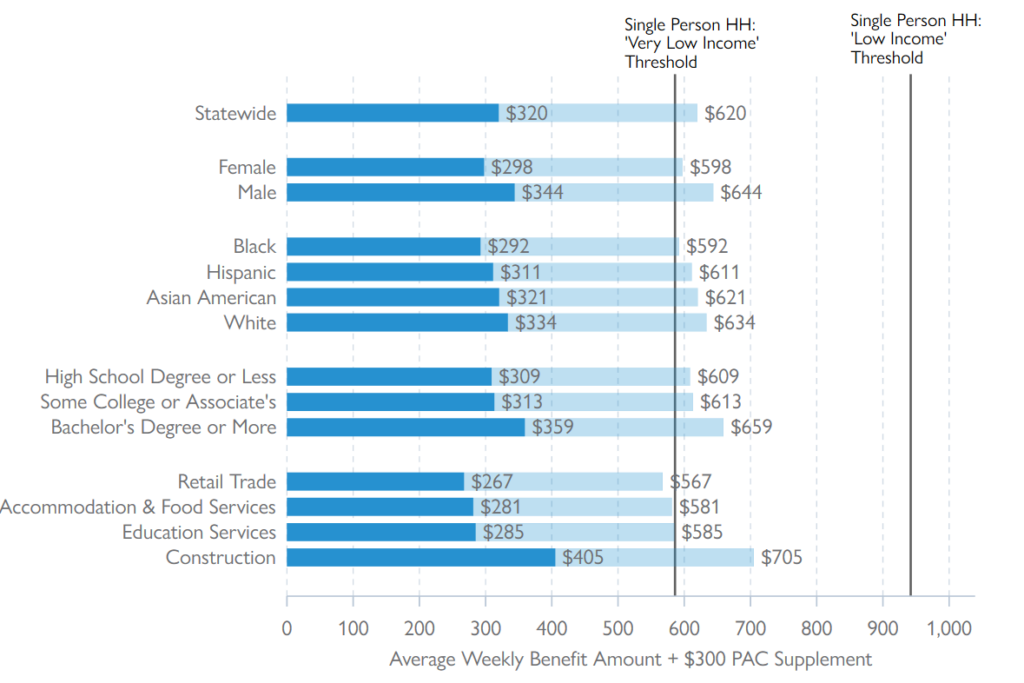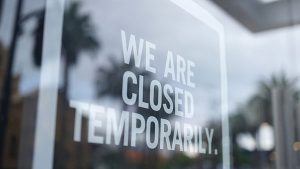Background: The COVID-19 crisis has led to historically unprecedented increases in the level of initial Unemployment Insurance (UI) claims filed in California since the start of the crisis in mid-March, 2020. Through a partnership with the Labor Market Information Division of the California Employment Development Department, the California Policy Lab is analyzing daily initial UI claims to provide an in-depth and near real-time look at how the COVID-19 crisis is impacting various industries, regions, counties, and types of workers throughout California.
Return to the main report page to see all of the policy briefs, data points, and media coverage.
Increasing Equity and Improving Measurement in the U.S. Unemployment System: 10 Key Insights from the COVID-19 Pandemic
Published April 12, 2022
By
PRESS RELEASE: New Report Shares 10 Key Insights on Measuring and Improving Equity in the Unemployment System
Individual-level data on who applied for and received UI benefits can provide crucial insights into understanding how the crisis evolved, how well the government’s response worked, and what the implications are for future crises. The pandemic also brought to the forefront more fundamental issues with our nation’s UI system, such as pervasive inequities in which workers actually receive benefits and large differences in benefit amounts and durations. While some of these issues have persisted for decades, a lack of access to individual-level UI data has prevented a deeper understanding of the extent of the inequities. This report highlights ten key insights about the UI system and the labor market that are based on CPL’s unique partnership with EDD and the unique data access this partnership provided.
Six Insights for Measuring Equity in Access and Receipt of Unemployment Insurance Benefits
1. Workers experienced unequal impacts from the pandemic as measured by CPL’s new cumulative measures of layoffs. In the first year of the pandemic, 31% of California’s pre-crisis labor force applied for regular unemployment benefits (not including PUA claimants). Female workers and workers with a high school degree or less had higher rates of UI claiming than other groups.
2. The recipiency rate (which measures how many unemployed workers are receiving UI benefits) increased during the pandemic. However, there were large disparities across communities. The extension programs were key drivers of the increase in recipiency rates, and nearly 4 of every 10 unemployed workers lost benefits when those programs expired in September 2021. California counties with higher incomes and more access to broadband internet were associated with high recipiency rates, while areas with a larger share of Hispanic individuals, people with limited English proficiency, and more COVID-19 cases were associated with lower rates.
3. The $600 and $300 UI supplements provided during the pandemic temporarily helped raise claimants’ incomes above the “very low” income threshold for single individuals, but disparities in weekly benefit amounts remained. Because of how UI benefits are calculated, males, more educated workers, and White workers typically receive higher UI benefit amounts than other workers.
Average Weekly Benefit Amounts of Initial Claimants for Regular Unemployment Insurance Over the Course of the COVID-19 Crisis

Notes: Weekly Benefit Amounts are the average among all new initial claims (for Regular UI) filed between March 15th, 2020 and October 16, 2021. It does not include new claims filed when individuals transition to extension programs. The average benefit amount for individuals who either did not self-identify their race or self-identified as a different racial group is not shown.
4. The Pandemic Emergency Unemployment Compensation (PEUC) program and the Extended Benefits (EB) program helped reduce the number of people who ran out of UI benefits during the crisis, but there were substantial differences in exhaustion rates by demographic group. About a quarter of UI claimants who entered at the beginning of the pandemic exhausted their benefits with older workers, Black workers, and less educated workers exhausting their benefits at higher rates than other groups.
5. Due to a flaw in how states determine if Extended Benefits (EB) are available, California and 39 other states ended their EB programs while many people still counted on them. If Congress reformed automatic benefits triggers to align with CPL’s improved Insured Unemployment Rate trigger (which also counts claimants in extension programs), these 39 states would have been able to provide claimants who had exhausted state UI benefits with an additional 13 weeks of benefits.
6. Re-employment and recall rates one year after the start of the pandemic had steadily increased, but remained lower for less-educated workers than during the pre-pandemic expansion period. In contrast, a higher share of workers returned to their previous employer and remained in their previous industry. The employment outcomes of workers receiving UI are typically not visible to policymakers, but can provide important insight into the pace of recovery and needs for intervention across types of workers and labor markets.
The Shortcomings of Current Measures of Unemployment Benefits and 4 Insights to Improve Them
7. Initial claims are one of the most watched measures of unemployment, yet CPL's research found that this measure dramatically overstates the number of individuals entering the UI system each week. Between the start of March 2021 to October, there were 2.7 million initial claims for regular UI in California— but during that same time period, there were only 1.9 million individuals who entered the regular UI system. In other words, the typical interpretation of the initial claims measure overstates the number of individuals claiming regular UI by 42% during this time period. CPL created a new measure called Entries into Paid Unemployment that more accurately measures the number of people entering (or re-entering) the UI system.
8. CPL’s new measure of Entries into Paid Unemployment based on actual payments also clarifies the total amount of churn in and out of the system. In 2021, between 30% and 40% of all claimants who left the UI system returned after four weeks. Across demographic groups, White workers, female workers, and older workers were more likely to suffer repeated job loss and multiple UI spells.
9. CPL’s new metric measures the number of UI claims based on when unemployment was actually experienced and provides a more accurate and timely measure of the labor market. Official UI statistics count the number of claims certified each week, not the number of people experiencing unemployment each week. If individuals retroactively certify for benefits or state agencies are delayed in certifying benefits for unemployment experienced in the past, then the published UI measures could provide a distorted view of the timing of unemployment. For example, in the week ending August 29th, there were ~10 million continued claims reported to DOL. In actuality, only ~4.5 million individuals collected benefits in that week.
10. Partial and denied UI payments can shed light on how the UI system interacts with people who are still connected to their employer. Through most of the pandemic, the share of UI claimants receiving partial payments hovered between 9% and 11% and the share being denied payments due to excess earnings was between 5% and 6%, indicating that many UI claimants continued to work (albeit at reduced amounts) and received lower benefits as a result. Recipients on extension programs worked less than people on Regular UI, which is why both series increase after the extension expirations.
Suggested Citation: Bell, A., Hedin, T.J., Mannino, P., Moghadam, R., Schnorr, G., von Wachter, T. (2022). Increasing Equity and Improving Measurement in the U.S. Unemployment System: 10 Key Insights from the COVID-19 Pandemic. California Policy Lab. https://www.capolicylab.org/publications/increasing-equity-and-improving-measurement-in-the-us-unemployment-system-10-key-insights/

